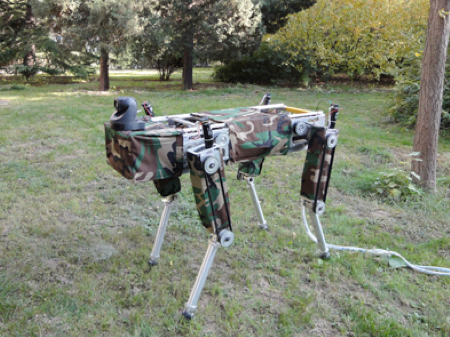![[IMG]](http://img.cjdby.com/data/attachment/forum/201408/31/121453crp88pqtfyu824q4.jpg) |
Da Gou This photo from a robotics expo in August 2014 shows a four legged "robot mule" developed by NORINCO
![[IMG]](http://www.popsci.com/sites/popsci.com/files/styles/image_full/public/Da%20Gou.jpg?itok=sCLv0Mps) |
"Da Gou", which is Mandarin for Big Dog. Officially named Mountainous Bionic Quadruped Robot
Developed by the NORINCO Vehicle Research Institute of arms manufacturer
NORINCO, this "Da Gou" weighs 130kg by itself and can carry a 30kg
payload. Da Gou can trot at a speed of about 6 kilometers an hour, and
can handle slopes of up to 30 degrees. The Da Gou's size speed and
slope climbing capability is similar to that of Big Dog (110 kg, 6.4 kmh
and 35 degrees), Big Dog and LS3 carries 150-300kg of cargo.
The smaller carrying capacity of Da Gou indicates that the NORINCO
program is still in the very early stages of technology demonstration;
future models will likely have greater carrying capacity, speed and
batteries that exceed the current two hours of operation. Similar to
LS3's military mission, "Da Gou" is intended to carry supplies alongside
infantry in mountainous and urban terrain, the placard at the exhibit
also indicates that Da Gou is intended to serve in disaster relief
efforts and conduct battlefield reconnaissance as well. And just like
LS3, "Da Gou" could potentially carry weapons in the future.
![[IMG]](http://www.popsci.com/sites/popsci.com/files/big%20dog%20kicked.gif)
|
|
![[IMG]](http://img.cjdby.com/data/attachment/forum/201301/19/182442vr61io11o9vz499r.jpg.thumb.jpg)
Research done at the Robotics Centre of the University of Shandong
![[IMG]](http://himg2.huanqiu.com/attachment2010/2013/0117/20130117105234639.jpg)

Four-legged Robot for Optimal Gait, a quadruped developed by Dr. Wei Wang's team at the
Institute of Automation, part of the Chinese Academy of Sciences, in Beijing.
Robocop 1
![[IMG]](http://www.theoldrobots.com/images27/ED209-2.JPG)
Bigdog
![[IMG]](http://upload.wikimedia.org/wikipedia/commons/thumb/d/dd/Big_dog_military_robots.jpg/800px-Big_dog_military_robots.jpg) BigDog is the alpha male of the Boston Dynamics robots. It is a
rough-terrain robot that walks, runs, climbs and carries heavy loads.
BigDog
BigDog is the alpha male of the Boston Dynamics robots. It is a
rough-terrain robot that walks, runs, climbs and carries heavy loads.
BigDog
is powered by an engine that drives a hydraulic actuation system.
BigDog has four legs that are articulated like an animal’s, with
compliant elements to absorb shock and recycle energy from one step to
the next. BigDog is the size of a large dog or small mule; about 3 feet
long, 2.5 feet tall and weighs 240 lbs.
BigDog's on-board computer controls locomotion, servos the legs and
handles a variety of sensors. BigDog’s control system keeps it balanced,
navigates, and regulates its energetics as conditions vary. Sensors for
locomotion include joint position, joint force, ground contact, ground
load, a gyroscope, LIDAR and a stereo vision system. Other sensors focus
on the internal state of BigDog, monitoring the hydraulic pressure, oil
temperature, engine functions, battery charge and others.
In separate tests BigDog runs at 4 mph, climbs slopes up to 35 degrees,
walks across rubble, climbs a muddy hiking trail, walks in snow and
water, and carries a 340 lb load. BigDog set a world's record for legged
vehicles by traveling 12.8 miles without stopping or refueling.
The ultimate goal for BigDog is to develop a robot that can go anywhere
people and animals can go. The program is funded by the Tactical
Technology Office at DARPA.
----------------------------------------------------------------------------
Google robot called 'big dog'
- Officially known as the 'Legged Squad Support System', it has taken
five years to develop - and has been nicknamed Cujo by Marines
- Can walk and run over rugged terrain, following a soldier while carrying their kit and weapons
- Being used in Hawaii to deliver water to troops on training exercises
![[IMG]](http://i.dailymail.co.uk/i/pix/2014/07/15/article-0-1FA5710B00000578-723_634x421.jpg)
![[IMG]](http://i.dailymail.co.uk/i/pix/2014/07/15/article-0-1FA569B200000578-696_634x424.jpg)
The LS3 is a robotic mule, capable of traversing rugged terrain with Marines while carrying much of their load.
It is programmed to follow an operator and detect large terrain objects to maneuver around.
The testing for the LS3 is being observed by the Marine Corps
Warfighting Lab during the Advanced Warfighting Experiment as part of
Rim of the Pacific 2014, a military multilateral training event
featuring 22 nations and roughly 25,000 people.
Lance Cpl. Brandon Dieckmann, a Las Vegas soldier, was given the task of
controlling Cujo. - and admits he remembers watching clips of the LS3
on Youtube before he joined the infantry.
He said he never would have guessed he would be chosen to operate the
machine, which has been affectionately nicknamed 'Cujo' by his company.
![[IMG]](http://i.dailymail.co.uk/i/pix/2014/07/15/article-0-1FA569E200000578-76_634x424.jpg)
![[IMG]](http://i.dailymail.co.uk/i/pix/2014/07/15/article-0-1FA5714C00000578-360_634x424.jpg)
![[IMG]](http://i.dailymail.co.uk/i/pix/2014/07/15/article-0-1FA5713000000578-796_634x424.jpg)
The LS3 is being used as a logistical tool during RIMPAC as opposed to a
tactical tool, due to its loud noise during movement and problems
traversing certain terrains.
'I’d say 70 to 80 percent of the terrain we go through, it can go through,' Dieckmann said.
'There are times when it is going to fall over, but most of the time it can self-right and get back up on its own.
![[IMG]](http://i.dailymail.co.uk/i/pix/2014/07/15/article-0-1FA52FFE00000578-599_634x421.jpg)
![[IMG]](http://i.dailymail.co.uk/i/pix/2014/07/15/article-0-1FA569C600000578-979_634x423.jpg)
'Even if it doesn’t, it can take one person to roll it back over. The
way it is designed is that you can easily roll it back over.'
Huberth Duarte, an infantryman with India Co., 3/3, and an operator for
the LS3, says the robotic mule has become like a dog to him.
The controls are simple to learn and have joysticks, and he said it 'feels like playing Call of Duty.'
Putting the LS3 in the hands of young Marines is vital to the
development of the program, said Ben Spies, a contractor with Boston
Dynamics observing the AWE.
'We give the military hands-on so we can see what they will use it for instead of putting it in a parking lot.
'It helps us develop it more, because right now, only the engineers have it.'
![[IMG]](http://i.dailymail.co.uk/i/pix/2014/07/15/article-0-1FA569AE00000578-851_634x424.jpg)
![[IMG]](http://img.cjdby.com/data/attachment/forum/201408/31/121453crp88pqtfyu824q4.jpg)
![[IMG]](http://img.cjdby.com/data/attachment/forum/201301/19/182442vr61io11o9vz499r.jpg.thumb.jpg)
![[IMG]](http://himg2.huanqiu.com/attachment2010/2013/0117/20130117105234639.jpg)

![[IMG]](http://upload.wikimedia.org/wikipedia/commons/thumb/d/dd/Big_dog_military_robots.jpg/800px-Big_dog_military_robots.jpg)

![[IMG]](http://www.popsci.com/sites/popsci.com/files/styles/image_full/public/Da%20Gou.jpg?itok=sCLv0Mps)
![[IMG]](http://www.popsci.com/sites/popsci.com/files/big%20dog%20kicked.gif)
![[IMG]](http://i.dailymail.co.uk/i/pix/2014/07/15/article-0-1FA5710B00000578-723_634x421.jpg)
![[IMG]](http://i.dailymail.co.uk/i/pix/2014/07/15/article-0-1FA569B200000578-696_634x424.jpg)
![[IMG]](http://i.dailymail.co.uk/i/pix/2014/07/15/article-0-1FA569E200000578-76_634x424.jpg)
![[IMG]](http://i.dailymail.co.uk/i/pix/2014/07/15/article-0-1FA5714C00000578-360_634x424.jpg)
![[IMG]](http://i.dailymail.co.uk/i/pix/2014/07/15/article-0-1FA5713000000578-796_634x424.jpg)
![[IMG]](http://i.dailymail.co.uk/i/pix/2014/07/15/article-0-1FA52FFE00000578-599_634x421.jpg)
![[IMG]](http://i.dailymail.co.uk/i/pix/2014/07/15/article-0-1FA569C600000578-979_634x423.jpg)
![[IMG]](http://i.dailymail.co.uk/i/pix/2014/07/15/article-0-1FA569AE00000578-851_634x424.jpg)
Post a Comment Blogger Facebook Disqus